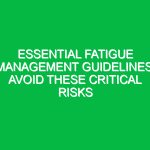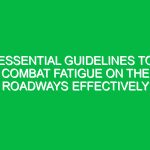“`html
Essential Guidelines to Combat Fatigue on the Job for a Safer Workplace
Good morning team! Today, we are here to discuss an essential topic that affects all of us in the workplace: combatting fatigue on the job. Fatigue can significantly impact our Safety, productivity, and overall well-being. Understanding how to manage fatigue is crucial for maintaining a safe work Environment. Let’s dive into why this topic is vital and how we can all contribute to a safer workplace.
Understanding Combatting Fatigue on the Job
Fatigue is a physical and mental state of exhaustion that can be caused by prolonged work hours, lack of rest, and insufficient sleep. It can impair cognitive functions, reduce attention, and increase the likelihood of accidents. In our line of work, where attention to detail is critical, even a moment of distraction can lead to serious incidents.
Many employees mistakenly believe that fatigue is just a natural part of working long hours. However, it’s important to recognize that chronic fatigue can lead to severe consequences, including workplace injuries, decreased morale, and lower productivity. By addressing fatigue proactively, we can enhance our work environment and safety Standards.
Key Hazards, Risks, and Safety Considerations
Understanding the risks associated with fatigue is the first step in combating it. Here are some specific Hazards to consider:
- Increased Accident Risk: Fatigued workers are more likely to make mistakes or overlook safety protocols, leading to accidents.
- Decreased Productivity: Fatigue can slow down reaction times and decision-making, ultimately affecting overall productivity.
- Health Issues: Chronic fatigue can lead to serious health problems, including cardiovascular diseases and mental health disorders.
Real-world consequences of ignoring fatigue can be severe. For example, several industries have reported incidents where fatigue directly contributed to workplace accidents, resulting in injuries or even fatalities. Recognizing these risks is vital for our safety and the safety of our colleagues.
Best Practices, Procedures, & Actionable Advice
Now that we understand the risks associated with fatigue, let’s discuss some Best Practices to combat it:
1. Prioritize Sleep
Encourage everyone to establish a regular sleep schedule. Aim for 7-9 hours of quality sleep each night to ensure you are well-rested for work.
2. Take Regular Breaks
Implement a policy of taking short breaks every hour. Use this time to rest your eyes, stretch, and recharge. Remember, a few minutes can significantly enhance your focus and energy levels.
3. Stay Hydrated and Nourished
Dehydration and poor nutrition can exacerbate fatigue. Always keep water accessible and opt for healthy snacks that provide sustained energy.
4. Manage Workloads Wisely
Encourage open communication about workload concerns. If someone feels overwhelmed, it’s essential to discuss workload management and seek assistance when needed.
5. Promote a Supportive Work Culture
Foster an environment where employees feel comfortable discussing fatigue and mental health. Encourage team members to support each other and recognize signs of fatigue.
Real-Life Example
Consider the case of a construction site where workers were routinely pushing through long hours without adequate breaks. This led to a series of near misses. After implementing a structured break schedule and promoting awareness about fatigue, incidents dropped significantly, showcasing the importance of addressing fatigue proactively.
Regulations, Standards, and Compliance
Adhering to safety Regulations is critical for our workplace. Relevant standards from organizations like OSHA emphasize the importance of managing fatigue as part of overall Workplace Safety. Compliance with these standards not only protects employees but also enhances the organization’s commitment to safety.
Each of us has a role in ensuring compliance by following established protocols and participating in safety Training. Remember, safety is a collective responsibility.
Employee Engagement & Discussion
As we wrap up, let’s open the floor for discussion. Here are a few questions to consider:
- What are the most common fatigue-related challenges you face in your role?
- Have you noticed any specific times or situations when fatigue affects your performance?
- What strategies do you currently use to manage fatigue on the job?
Feel free to share your thoughts and experiences. Remember, open dialogue can lead to better strategies and a safer workplace.
Conclusion & Key Takeaways
In conclusion, combatting fatigue on the job is essential for a safer workplace. By prioritizing sleep, taking regular breaks, and fostering a supportive work culture, we can significantly reduce the risks associated with fatigue. Remember, each one of us plays a crucial role in maintaining our safety and well-being at work.
Thank you for your time and commitment to safety. Let’s continue to prioritize our health and support one another in creating a safer work environment!
“`


